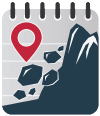

Q: Do I have to answer all the questions? What if I don't know something?
A: You don't have to fill out all the fields. If you don't know the answer, leave it blank. Only the source of your information is required.
Q: How accurate does my location information need to be?
A: While precise locations are much more useful for research, it's better to describe what you do know, rather than give exact coordinates that might be wrong. So if you only know what country it happened in, just write that.
Q: Can I report a landslide that happened in the past?
A: Yes. Just make sure to provide the date when the landslide occurred, not today's date. If you only have a rough idea of when it happened, you can describe it at the end.
Q: Can I report landslides from news articles or other second-hand sources?
A: Yes, we accept reports from a variety of sources, including news articles and social media.
Q: What should I do if I witness an active landslide?
A: Your safety is the top priority. If you witness an active landslide:
Q: How do I submit my report?
A: After filling out the form, click the "Email this report" button. This will open your default email client with a draft message containing your report. Review the information and send the email to submit your report.
Q: Do you publish my personal information?
A: No, we do not put your personal information in the database. However, the person reading your report will see your email address. If you want total anonymity, please consider creating a new email account for the sole purpose of reporting landslides.
Q: Why didn't my report show up at Landslide Viewer?
A: We probably haven't updated the online database yet, but you can check your sent email folder just to verify that the report went out. It's also possible that a large attachment might have led our inbox to filter it. If it's been a few weeks and you still don't see your report, feel free to reply to your original email.
Q: Can I update or correct a report I've already submitted?
A: Yes, if you have new information or need to correct a submitted report, please "reply all" to your original emailed report.
Q: I have a lot of landslides to report. Is there a faster way?
A: Our system is designed for individual reports. If you have multiple landslides to report, please contact gsfc-landslidereporter@mail.nasa.gov, and we can discuss the best way to get your information.
Q: Are there any types of landslides you're particularly interested in?
A: Our research has been focused on landslides triggered by rainfall, but all landslide reports may be valuable to science.
Q: Is this project only for the United States, or can I report landslides from anywhere in the world?
A: Please feel free to report landslides anywhere on Earth, regardless of where you live.
Q: How does NASA use this landslide data?
A: NASA uses your reports to study the relationship between landslides and rainfall and to evaluate the global landslide nowcast.
Q: How can I see all the reported landslides?
A: You can view the Landslide Reporter Catalog through the Landslide Viewer application. This interactive map allows you to explore landslides from around the world.
Q: Can I use this data for my own research?
A: Yes, the data is publicly available at Landslide Viewer. When using the Landslide Reporter Catalog, please cite the following article:
Juang, C.S., Stanley, T.A., Kirschbaum, D.B. (2019).
"Using citizen science to expand the global map of landslides: Introducing the Cooperative Open Online
Landslide Repository (COOLR)."
PLOS ONE 14, e0218657.
10.1371/journal.pone.0218657
Q: Why don't you just use satellites and artificial intelligence to find these landslides?
A: We do use satellite imagery and machine learning to map landslides (e.g.: https://github.com/nasa/salad). However, these methods may not capture all landslides, especially when obscured by vegetation or clouds. Also, ground-based reports can provide additional details such as the exact timing, local conditions, and impacts.